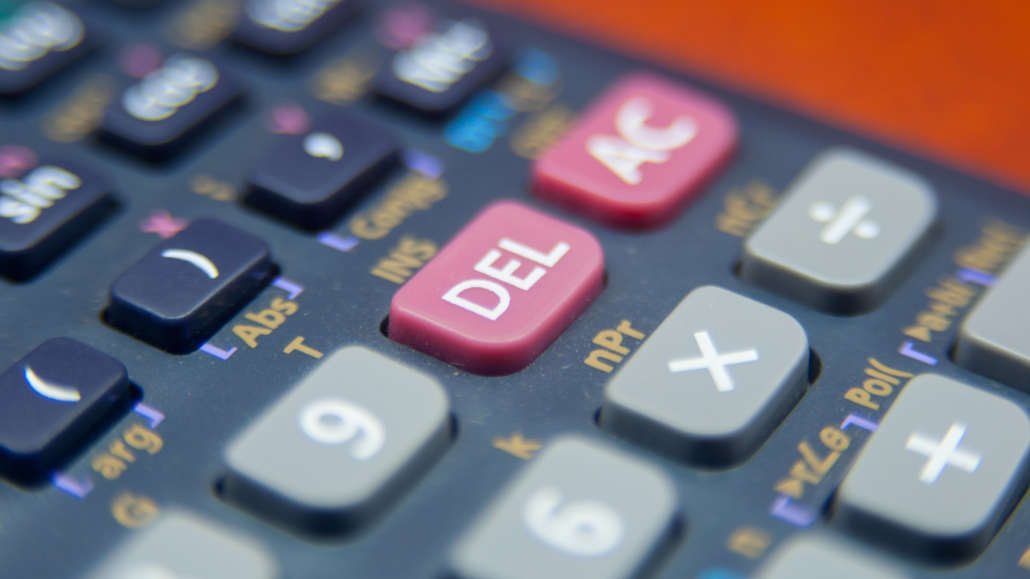Poker Math Basics – Build the Right Fundamentals

10 minutes
Last Updated: December 20, 2021
To a random bystander watching a game of poker randomness and chance appear to dominate the affair to such a degree that there is very little players can do to influence the final outcome.
This popular misconception is, in fact, one of the biggest reasons for the massive popularity that Texas Hold’em enjoys worldwide. Players from all walks of life believe they can be winners if they are just lucky enough.
Of course, those of us who have dedicated more of our lives to poker understand that it is a game of skill and mathematics and one that starts with the understanding of some basic underlying mathematical principles.
If you don’t yet believe that poker math is a real thing and that it matters in the game, this guide might help change your mind and show you how you can become a long-term winner at poker as well.
On the other hand, if you are already a successful poker player, it won’t hurt to look back at some of the fundamentals of the mathematics of poker.
Poker Math & Understanding Probability
When we talk about skill and math in poker, many players dismiss it for one simple reason. Even players with no understanding of poker math often end up being winners on the night.
However, one thing I can guarantee you is that players with no conception of the poker math cannot come out on top over the long run against competent players.
If you want to make sure that what I am saying is true, try taking notes and tracking the results of players in your local or home games over the course of several dozen sessions.
In most cases, the players who seem oblivious of basic poker concepts will end up being the big losers.
So why is it that on some nights, even these players will come out on top? The reason is quite simple. Probability is a concept that takes time to realize itself in full.
For example, if we took five hands to showdown as an 80% favorite each time, there is still a very small chance that we would lose all five.

The chance of losing money by three of the five hands going the other way is more reasonable, although small, which means anyone can win on a given session.
Of course, situations in which we are 80% favorites are not too common in poker, and the edges are often thinner than that. That's why it can take a while for the best poker players to beat their opposition.
However, after many repetitions, players who make fundamental poker math mistakes are going to get crushed by those who don’t make such mistakes. That is just the harsh reality of poker.
What is the Long Term and Tracking Poker Results
The big problem many players have with poker is understanding how to track the results in the game. They focus on single wins or sessions where they had above-average runs of cards and base the conception of their skill level on these.
However, you can only tell how well you are doing in poker once you have played many poker hands in cash games or many individual tournaments.
In cash games, you will be able to tell your win rate in big blinds won per hour (BB/hour). In tournaments, you can calculate your return of investment (ROI) compared to your buyins.
To get the correct number on either of these, you will need a big sample. The bigger your actual win rate, the smaller sample you will need to calculate it.
Yet, if the games are particularly wild, such as live cash games, the calculations will take even more time.
If you want to get a good assessment of how well you are doing in particular games, I recommend putting in at least:
- 50,000 hands of live cash games
- 1,000 hours of live cash games
- 2,000 sit & goes
- 500 multi-table tournaments
This number of repetitions should give you a relatively clear picture of how well you are doing in particular games. Of course, remember that this poker math only works if you are playing all the games on the same or similar buyin level.
What I mean by this is that your ROI will differ in a $215 online tournament with 100 runners and a $5 online tournament with thousands of runners, many of whom are absolute amateurs.
If you put in this kind of sample and are losing over it, I recommend getting more help with mathematics of poker fundamentals. Keep reading to brush up on those and learn how you can apply math in the actual game.
Poker Math Basics: Counting Outs and Calculating Equity
Whenever you watch poker online these days, you will see numbers in percentages next to players' names on the screen.
These percentages represent their equity in the hand, and any skilled poker player has to start out by knowing how to calculate this equity.
To start things off, you will need to understand whether your hand is likely to be the best at the moment or if it needs to be improved to win the pot.
In most cases, you will either have a made hand (one pair, two pair, three of a kind…) or a draw (open-ended straight draw, flush draw, gutshot straight draw…), while in others, you may have a combination of the two.

At this point in the hand, you can start to think about the odds of making your hand by the river by finding one of the cards you still need (your outs).
For example, if you imagine yourself sitting with Kc Qc on an Ac 9d 5c board and facing a bet, your hand is usually not good. However, a club on the turn or river will make your hand into an ace-high flush, which is the best possible hand.
In a situation like this, knowing how to count your outs and how to convert those outs into equity is what will separate you from the unskilled players.
In our particular example, you have nine outs, with each of the nine remaining clubs in the deck making you a flush. The nine of clubs will also open up full house possibilities, which means it is not a pure out and does not give you the nuts.
Yet, all nine of these cards will greatly improve your hand and, in most cases, give you the pot by the river. But how much equity does that give us?
The simple rule to calculate your equity is to multiply your number of outs by four if you are on the flop or by two if you are on the turn.
In our example, we would have 36% equity in the hand (9 outs x 4 = 36%). If we miss on the turn, we will still have about 18% equity going to the river.
To skip on calculating your outs and odds every time you find yourself drawing, here are the out counts and Texas Hold’em for some popular situations:
| Poker Hand | Equity on the Flop | Equity on the Turn |
| Gutshot Straight Draw | 16.5% | 8.5% |
| Flush Draw | 35% | 19.6% |
| Open-Ended Straight Draw | 31.5% | 17.5% |
| Open-Ended Straight Flush Draw | 54.1% | 32.6% |
| Gutshot Straight Flush Draw | 45% | 26.1% |
| Set to Full House | 27.8% | 15.2% |
| Two Pair to Full House | 16.5% | 8.7% |
There are countless other situations in which you can use this basic poker math principle to calculate your equity and find out how you stand against your opponent’s possible hands.
After learning this, you are probably wondering how this will help you win at poker. After all, knowing how likely you are to win does not mean you can influence those odds.
However, not being to influence the odds of making your hand does not mean you cannot influence what happens in the hand.
Knowing your equity will help you make the right calls and folds, and you will do this by understanding the concept of pot odds.
How Pot Odds Work
Now we know how to calculate our odds to win the hand, and we can proceed to make decisions on whether to call our opponent's bet or not.
Let us go back to the example in which we were holding Kc Qc on the Ac 9d 5c board for the nut flush draw. By using the simple rule of 4 (multiplying our outs by 4), we know we have about 36% equity to make our flush by the river.
Now imagine there was $100 in the pot, and your opponent bet $50 into the pot. The decision is now on you, and you have to decide whether to call, raise, or fold.
Many players try to use intuition or guess whether the club is coming or not in this situation. This is not the way you should be approaching poker.

Instead, it is time to calculate our pot odds and make our decision based on knowing our equity in the hand and knowing the size of the bet we are facing.
Since our opponent is betting $50 into a $100 pot, we will be getting pot odds of 3:1. We come up with this number by adding together the $50 he bet, the $50 we will be calling with, and the $100 already in the pot.
Since there will be $200 in the pot, and we only need to call $50 to see the next card, we only need 25% equity to make this call profitable. Since we have 36% equity, we can easily make this call and be printing money with it.
Things get trickier in terms of the mathematics of poker if our opponent chooses to bet $100 into this pot. We now need 33% equity to make a call profitable since we are only getting laid pot odds of 2:1.
Again, we have 36% equity, which means we can call without much trouble. The real problems would start if we had fewer outs with a hand like a gutshot straight draw or bottom pair.
The next thing we need to take into account here is the implied odds, which I am going to briefly explain in the next chapter.
Using Implied Odds
Unlike pot odds, which are fairly simple to understand, implied odds are a slightly more abstract concept.
Implied odds refer to the money you stand to win on top of the current pot if you do make your hand.
For example, if we make the flush in our previous example, our opponent might be reluctant to let us win much more money, as the possibility of us holding a flush will be quite high.
On the other hand, if we called the bet with a hand like a gutshot straight draw and made our hand, it would be much more concealed. This makes it harder for our opponent to get away from his made hand.
Without going too deep into poker math of implied odds, remember that you should always be looking at your opponent’s stack size, your own stack size, and the size of the current bet relative to poker chips left behind.
The concept of implied odds can also come in handy in pre-flop situations when you hold speculative hands like small pocket pairs. Don’t go set mining unless your opponent has at least ten times as much money behind as there is currently in the pot.
By keeping an eye on the effective stack sizes and the chances of winning more money from your opponent on later streets, you can know when to chase your draws and when to get away from them.
Apply the Mathematics of Poker In-Game
There is a lot more to say on poker math, but I have explained a few of the most basic concepts in this short guide.
You should now understand how knowing your own equity in a poker hand, as well as your pot odds and implied odds, can help you make the right calls and folds, and be better at the game than your opponents.

Even just applying these basic Texas Hold’em odds and concepts to the game will give you a great edge over those who don't understand them.
You will know when to keep going and when to fold and move on to the next hand.
If you are still curious about the mathematics of poker, keep reading and find out some probabilities that you should know for the next time you play.
Poker Math Summary: Probabilities in Poker
Wondering how likely you are to get pocket aces or flop a set? Here is a shortlist of some of the most common situations in poker, as well as some less common ones, and how likely they are to happen:
- Getting dealt AKs (or other specific suited cards): 331/1
- Getting dealt AA (or other specific pocket pair): 220/1
- Getting dealt AK: 81.9/1
- Getting dealt big pocket pair (JJ+): 54.3/1
- Getting dealt suited connectors: 24.5/1
- Getting dealt a pocket pair: 16/1
- Flopping a flush: 118/1
- Flopping a set: 7.5/1
- Flopping a pair: 2.45/1
- An overcard on the flop when you hold KK: 22.6%
- An overcard on the flop when you hold QQ: 41.4%
- Three cards of the same suit on the flop: 18.3/1
- Rainbow flop: 1.51/1
- Three of a kind on the flop: 424/1
- A pair on the flop: 4.90/1


















